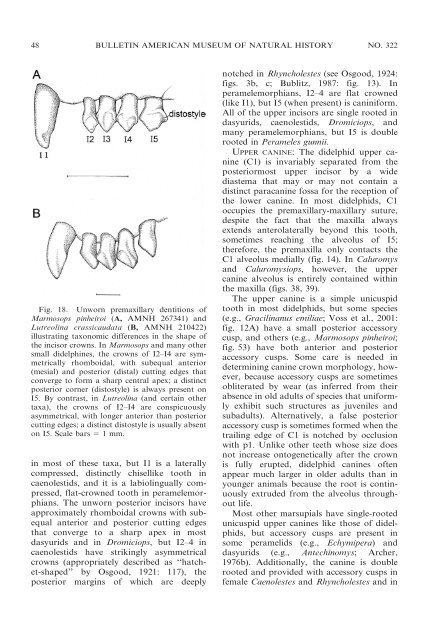phylogenetic relationships and classification of didelphid marsupials ...
phylogenetic relationships and classification of didelphid marsupials ...
phylogenetic relationships and classification of didelphid marsupials ...
Create successful ePaper yourself
Turn your PDF publications into a flip-book with our unique Google optimized e-Paper software.
48 BULLETIN AMERICAN MUSEUM OF NATURAL HISTORY NO. 322<br />
Fig. 18. Unworn premaxillary dentitions <strong>of</strong><br />
Marmosops pinheiroi (A, AMNH 267341) <strong>and</strong><br />
Lutreolina crassicaudata (B, AMNH 210422)<br />
illustrating taxonomic differences in the shape <strong>of</strong><br />
the incisor crowns. In Marmosops <strong>and</strong> many other<br />
small didelphines, the crowns <strong>of</strong> I2–I4 are symmetrically<br />
rhomboidal, with subequal anterior<br />
(mesial) <strong>and</strong> posterior (distal) cutting edges that<br />
converge to form a sharp central apex; a distinct<br />
posterior corner (distostyle) is always present on<br />
I5. By contrast, in Lutreolina (<strong>and</strong> certain other<br />
taxa), the crowns <strong>of</strong> I2–I4 are conspicuously<br />
asymmetrical, with longer anterior than posterior<br />
cutting edges; a distinct distostyle is usually absent<br />
on I5. Scale bars 5 1mm.<br />
in most <strong>of</strong> these taxa, but I1 is a laterally<br />
compressed, distinctly chisellike tooth in<br />
caenolestids, <strong>and</strong> it is a labiolingually compressed,<br />
flat-crowned tooth in peramelemorphians.<br />
The unworn posterior incisors have<br />
approximately rhomboidal crowns with subequal<br />
anterior <strong>and</strong> posterior cutting edges<br />
that converge to a sharp apex in most<br />
dasyurids <strong>and</strong> in Dromiciops, but I2–4 in<br />
caenolestids have strikingly asymmetrical<br />
crowns (appropriately described as ‘‘hatchet-shaped’’<br />
by Osgood, 1921: 117), the<br />
posterior margins <strong>of</strong> which are deeply<br />
notched in Rhyncholestes (see Osgood, 1924:<br />
figs. 3b, c; Bublitz, 1987: fig. 13). In<br />
peramelemorphians, I2–4 are flat crowned<br />
(like I1), but I5 (when present) is caniniform.<br />
All <strong>of</strong> the upper incisors are single rooted in<br />
dasyurids, caenolestids, Dromiciops, <strong>and</strong><br />
many peramelemorphians, but I5 is double<br />
rooted in Perameles gunnii.<br />
UPPER CANINE: The <strong>didelphid</strong> upper canine<br />
(C1) is invariably separated from the<br />
posteriormost upper incisor by a wide<br />
diastema that may or may not contain a<br />
distinct paracanine fossa for the reception <strong>of</strong><br />
the lower canine. In most <strong>didelphid</strong>s, C1<br />
occupies the premaxillary-maxillary suture,<br />
despite the fact that the maxilla always<br />
extends anterolaterally beyond this tooth,<br />
sometimes reaching the alveolus <strong>of</strong> I5;<br />
therefore, the premaxilla only contacts the<br />
C1 alveolus medially (fig. 14). In Caluromys<br />
<strong>and</strong> Caluromysiops, however, the upper<br />
canine alveolus is entirely contained within<br />
the maxilla (figs. 38, 39).<br />
The upper canine is a simple unicuspid<br />
tooth in most <strong>didelphid</strong>s, but some species<br />
(e.g., Gracilinanus emiliae; Voss et al., 2001:<br />
fig. 12A) have a small posterior accessory<br />
cusp, <strong>and</strong> others (e.g., Marmosops pinheiroi;<br />
fig. 53) have both anterior <strong>and</strong> posterior<br />
accessory cusps. Some care is needed in<br />
determining canine crown morphology, however,<br />
because accessory cusps are sometimes<br />
obliterated by wear (as inferred from their<br />
absence in old adults <strong>of</strong> species that uniformly<br />
exhibit such structures as juveniles <strong>and</strong><br />
subadults). Alternatively, a false posterior<br />
accessory cusp is sometimes formed when the<br />
trailing edge <strong>of</strong> C1 is notched by occlusion<br />
with p1. Unlike other teeth whose size does<br />
not increase ontogenetically after the crown<br />
is fully erupted, <strong>didelphid</strong> canines <strong>of</strong>ten<br />
appear much larger in older adults than in<br />
younger animals because the root is continuously<br />
extruded from the alveolus throughout<br />
life.<br />
Most other <strong>marsupials</strong> have single-rooted<br />
unicuspid upper canines like those <strong>of</strong> <strong>didelphid</strong>s,<br />
but accessory cusps are present in<br />
some peramelids (e.g., Echymipera) <strong>and</strong><br />
dasyurids (e.g., Antechinomys; Archer,<br />
1976b). Additionally, the canine is double<br />
rooted <strong>and</strong> provided with accessory cusps in<br />
female Caenolestes <strong>and</strong> Rhyncholestes <strong>and</strong> in

















